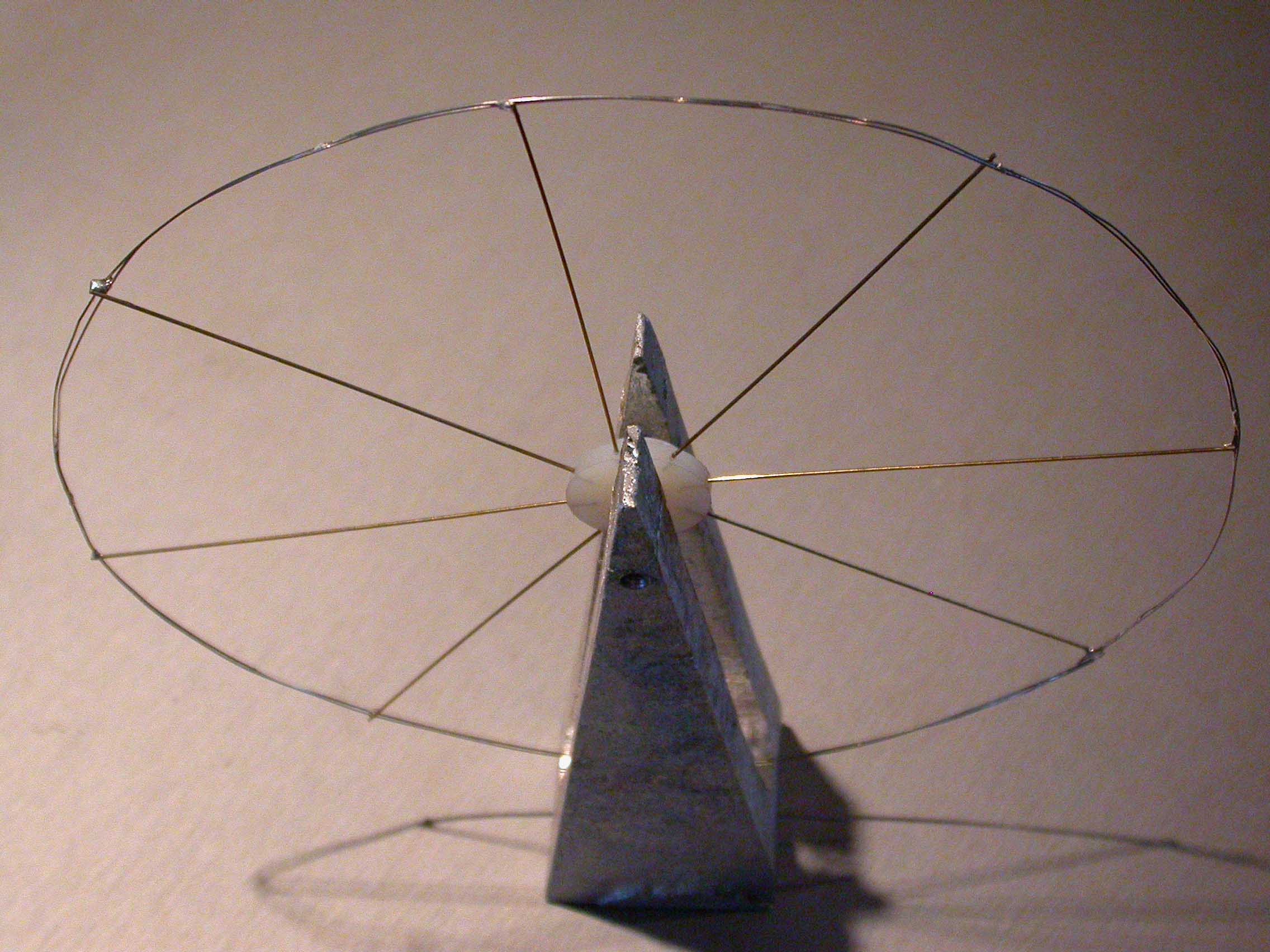
ALL MATERIAL COPYRIGHT KEVIN SCOTT 2011. LINKS TO THIS SITE ARE WELCOME BUT DO NOT COPY MATERIAL FROM THIS SITE TO ANY OTHER WEBPAGE.
If you find this site useful, please support it by making a donation of $1 to help maintain and develop it. Click on the PAYPAL DONATE button to do this safely. But there is no obligation - please avail yourself of the information and facilities of the site at no charge.

The prototype heat engine took the form of a wheel, 17cm in diameter, with a rim consisting of two turns of Monel 400 wire 0.4 mm in diameter, supported by 8 brass spokes set into a nylon hub 20mm in diameter through the axis of which a 1/16” diameter silver steel rod was passed. This rod was provided with ground points which rested in spherical depressions in the ends of M5 set screws mounted in the aluminium alloy stand. Inset 9 gives some indications of the stages of construction of the wheel.
The aluminium alloy stand was cast using a greensand mould. Patterns were prepared in beechwood using a milling machine to shape them to the form of a triangular prism. The triangular face was isosceles with an apical angle of 15 degrees and with a long side of 12 cm and a base of 39mm. The height of the prism was 35mm.
The patterns were sanded and finished to required smoothness and then rammed up with Lutron oil sand and wet casting sand into a cope of about 35cm square and 25 cm height. Parting sand was used to ensure the patterns could be extracted cleanly from the sand. Sufficient aluminium alloy was fused in a graphite crucible and heated to 900 deg C in a furnace. 20 gm of Degassit flux was stirred into the melt and the oxides drawn from the surface of the hot metal with a spatula. The metal was poured and the casting allowed to cool. After removal from the casting sand the castings were inspected and any flashing removed.
A hole 4.3mm diameter was drilled at right angles to the parallel faces of each casting 18 mm from the apex and tapped M5. A slot, 10mm wide was then milled through the castings from the tapered end to within 12 mm of the base. The base itself was bored out 10mm along the longitudinal axis of the prisms and a nylon tube, carrying the ceramic magnet inserted into the hole thus formed. The wheel was then mounted so that it ran smoothly in the milled slot and its periphery passed within 1 mm of the top of the ceramic magnet in the base.
When the finished prototype was placed on a surface at about 45 degrees Centigrade, and a few drops of water placed upon the top of the ceramic magnet in the base, the wheel rotated at approximately 12 rpm. The machine represents the simplest possible heat engine operating at a very small difference in temperature between source and sink. It is to be noted that the machine is not thermodynamically reversible and so cannot be treated as Carnot engine. If all extraneous heat losses could be removed the efficiency of the machine would be represented by the ratio of work done by the magnetic couple to the Curie latent heat of the Monel 400. This latter quantity, which has yet to be determined, is the amount of heat absorbed by the magnetic alloy when the Curie point is reach while it is in a magnetic field. Energy is absorbed in breaking up the domains aligned in the direction of the field. It is this quantity which will determine the theoretical effectiveness of the machine, while heat transfer factors will determine its practical realisation.
Density = 8.83gm/cc= 0.318 lb/cu. in.
Curie Point 20-50 deg Fahrenheit
Melting Point Range: 2370-2460 deg Fahrenheit
Modulus of Elasticity
Tension 26.0 ; Compression 26.0 Torsion 9.5
COMPOSITION: 67% Ni, about 30% Cu and up to 2.5% Fe.
Specific Heat 0.105Btu/lb/Deg F - [32-212 Deg F]
Electrical Resistivity 307 microhm-cm (at 68 Deg F)
Poissons Ratio 0.32
Temperature coefficient of resistance ( K-1 ) 0.0019
Mechanical Properties
Elongation at break ( % ) <40
Hardness - Brinell 125-190
impact strength ( J m-1 ) 110-140
Modulus of elasticity ( GPa ) 185
Tensile strength ( MPa ) 550-950
Coefficient of thermal expansion ( x10-6 K-1 ) 13.9-14.1 @ 20-100C
Maximum use temperature in air 450C
Thermal conductivity ( W m-1 K-1 ) 21.7 @ 23C